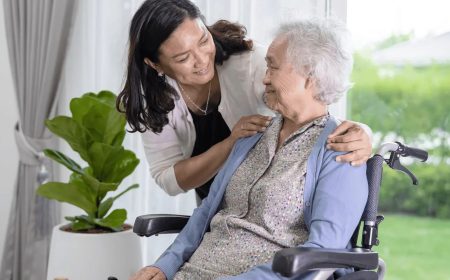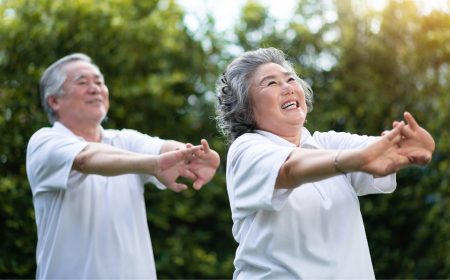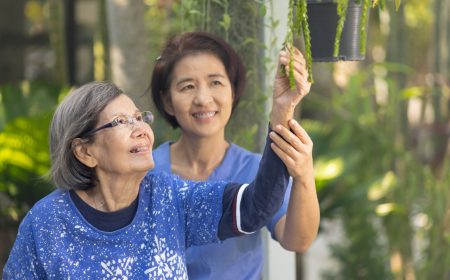Did you know that exercise is just as vital as medication in the management of Parkinson's symptoms?
Research shows that exercises like strength and balance training complement medical treatment by improving functional mobility, making everyday movements easier for those living with Parkinson's. Furthermore, growing evidence suggests that the neuroprotective (brain-protecting) effects of exercise may even potentially slow disease progression.1
To learn more about how regular strength and balance exercises can improve the long-term outcome of Parkinson’s disease, let’s first explore how the condition affects movement.
How Parkinson’s Affects Your Movement
Parkinson’s disease is a brain disorder that progressively impairs movement. It develops when cells in the brain that produce dopamine (a chemical that controls movement, coordination, and balance) are damaged and lost, leading to a shortage of dopamine.
Dopamine acts like a messenger that helps your brain send movement signals to your muscles. When dopamine levels drop, these signals become weaker, making it harder to control and coordinate movements.
As a result, people with Parkinson’s often experience motor-related (movement) symptoms such as:
- Tremors – Shaking in the hands, fingers, or legs, even when at rest.
- Muscle stiffness – Tightness that makes movement feel difficult.
- Bradykinesia – Slowed movement with actions requiring more time and effort.
- Postural Instability – Difficulty with balance, leading to higher risk of falling.
Why Exercise is an Essential Part of Parkinson’s Treatment
Exercise is an effective way for individuals with Parkinson’s to actively manage their symptoms and take control of their health and well-being.
Here are reasons why it’s so important for well-rounded Parkinson’s care.
Exercise Rewires Your Brain for Better Movement Control
Exercise stimulates the brain to find alternative routes for movement signals to reach your muscles, similar to taking a detour when a pathway is blocked. This rewiring process, known as neuroplasticity, allows the brain to adapt, grow new connections, and compensate for damage caused by Parkinson's.
Regular Physical Activity Supports Mental Well-Being
Depression and anxiety are among the biggest challenges for people with Parkinson’s, often affecting quality of life more than the physical symptoms.
Exercise combats this by triggering a release of endorphins, which are the body’s natural ‘feel-good’ chemicals. This translates to a natural boost in mood, stress reduction, enhanced mental clarity, and an overall sense of well-being.

Exercise is an Accessible and Affordable Way to Manage Parkinson’s
Exercise is inexpensive and can be tailored to meet individual needs at any stage of Parkinson's disease, making it a valuable addition to any treatment plan.
As a complementary approach alongside medication or surgery, it has the advantage of being natural, non-invasive, and free from side effects. Its flexibility and affordability make it one of the most accessible ways to manage Parkinson’s effectively.
How Strength and Balance Training Can Help You Move with Confidence
While regular exercise offers many benefits for managing Parkinson’s, research shows that balance and strength exercises are especially effective in tackling two key challenges of the condition—loss of functional movement and stability. Here’s a breakdown of how it works.
What is Strength Training?
Strength training is a type of exercise that involves working your muscles against some form of resistance, such as your own body weight or resistance bands to build muscle strength and endurance.
The Key Benefit of Strength Training For Parkinson’s
Increase in Muscle Power for Faster, More Coordinated Movements
Parkinson's typically leads to muscle loss, which makes everyday movements like walking and standing feel harder and more tiring.
Strength training helps individuals with Parkinson’s build and maintain the muscle strength necessary for everyday tasks. Studies show in addition to enhancing brain-to-muscle coordination and joint stability, it can boost muscle power between 15% to 82%.2 This leads to better movement control, enhanced speed, and a greater range of motion.
What is Balance Training?
Balance training is a form of exercise that aims to address instability and reduce the risk of falls, which are common problems for individuals with Parkinson's.
The Key Benefit of Balance Training For Parkinson’s
Reduced Risk of Fall
People with Parkinson’s are at a higher risk of falls due to balance problems and rigidity, with about 60% experiencing at least one fall annually.3
Balance training helps individuals with Parkinson’s stay steady on their feet by improving stability, reaction time, and coordination. It strengthens core muscles and trains reflexes, making it easier to recover from stumbles and maintain control while walking. Research shows that structured balance training can reduce the risk of falls by up to 40%.4
With regular strength and balance training, individuals with Parkinson’s can regain control over their movements allowing them to navigate daily life with increased confidence and safety.
Senior-Friendly Beginner Exercises for Parkinson’s
It’s normal for those with Parkinson’s to feel a little anxious about exercising. These gentle exercises are designed to be easy-to-follow and can be adjusted to match your current abilities, so you can regain strength and confidence at your own pace.
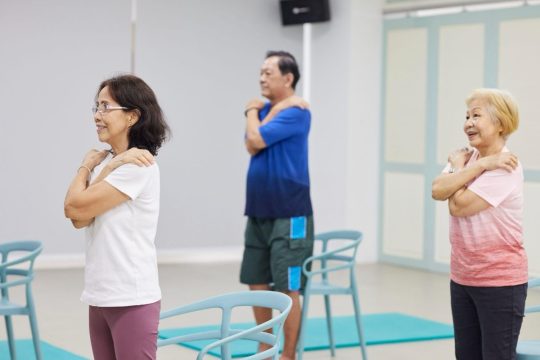
Chair Squats to Improve Leg Strength
Getting Ready:
- Sit in a strong, stable chair, preferably with armrests.
- Put your feet flat on the floor, about hip-width apart.
- Sit up straight, like you're trying to make yourself as tall as possible.
Stand Up:
- Lean forward slightly.
- Push through your feet to stand up.
- Stand up straight, but keep your knees relaxed.
Sit Down:
- Slowly lower yourself back into the chair.
- Sit back in a controlled manner, rather than just dropping down.
- Lightly touch the chair with your bottom, then stand up again.
Repeat:
- Perform 10–12 repetitions.
- If you get tired, take a short break and aim to do 2–3 sets.
Modifications:
- Easier: Sit on a pillow on the chair for an extra boost, or use the armrests for support.
- More Challenging: Stand without using the armrests, or hold the standing position for two seconds before sitting.
Resistance Band Bicep Curls for Arm Strength
Get Ready:
- Stand with your feet shoulder-width apart.
- Place a resistance band under the middle of your feet.
- Hold the ends of the band with your hands, palms facing up.
- Keep your elbows close to your sides.
The Curl:
- Keep your back straight.
- Slowly bend your elbows, bringing your hands towards your shoulders.
- Keep your upper arms still—only your forearms should move.
- Slowly lower your hands back to the starting position.
Repeat:
- Perform 10–12 repetitions.
Modifications:
- Easier: Use a thinner resistance band or perform the exercise sitting down.
- More Challenging: Use a thicker resistance band or increase the number of repetitions.
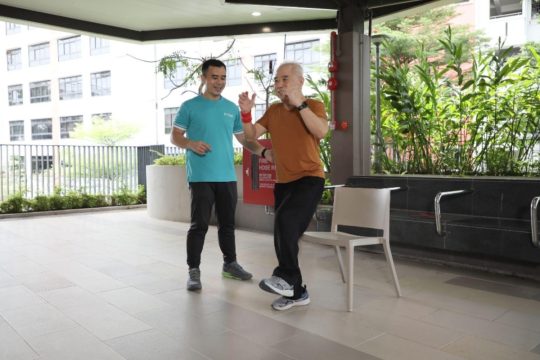
Single-Leg Stance for More Stability
Get Ready:
- Stand behind a sturdy chair, holding it with both hands for support.
- Position your feet hip-width apart.
- Maintain an upright posture, engaging your core.
The Stance:
- Slowly lift one foot a few inches off the floor, keeping the lifted leg slightly bent.
- Focus on maintaining balance on the standing leg.
- Hold the position for 5–10 seconds, keeping your back straight.
- Slowly lower the lifted foot back to the floor with control.
Repeat:
- Perform 5–10 repetitions on each leg.
Modifications:
- Easier: Lift your foot only slightly and reduce the hold time.
- More Challenging: Reduce the amount of chair support or use a thick exercise mat for added instability.
Coordinated Stepping for Better Balance
Get Ready:
- Stand behind a sturdy, stable chair, gripping it for support if needed.
- Maintain a tall posture with shoulders relaxed and gaze forward.
The Steps:
- Step forward with your right foot and return to the starting position.
- Step to the side with your right foot and return to the center.
- Repeat the steps with your left foot.
Repeat:
- Perform the entire sequence 5–10 times, maintaining smooth, controlled movements.
Modifications:
- Easier: Take smaller steps, move slowly while using the chair for support.
- More Challenging: Increase the speed, or add a small obstacle to step over.
Safety Tips for Exercising with Parkinson’s
Here are some essential tips to take note of before you begin any exercise:
- Keep a stable chair or wall within easy reach during exercise for support, especially during balance exercises.
- Stop exercising immediately if you experience any pain, dizziness, or shortness of breath, and rest.
- If you have severe balance or mobility issues, It’s best to exercise under supervision.
- Try to schedule exercise sessions at a time when your Parkinson's medication is most effective. This will maximise movement control during the workout.
- Certain Parkinson's medications can increase the risk of dehydration, so drink plenty of water before, during, and after exercise.
Join a Parkinson’s Exercise Class for Personalised Support
Managing Parkinson’s is easier when you have the right support. NTUC Health’s Parkinson’s Exercise Class is a specialised programme designed to help you move with confidence, build strength, and regain control over daily activities—all in a supportive environment alongside others who understand your journey.
Led by rehabilitation staff trained by Parkinson Society Singapore (PSS), this six-month regime offers structured exercise sessions tailored to your unique needs. But it goes beyond just exercise. It’s a space where you can share experiences, pick up practical strategies to manage movement disruptions like freezing, and receive professional guidance on Parkinson’s management every step of the way.
Weekly sessions are held at various Rehabilitation and Physiotherapy Centres located islandwide for your convenience. Those who require additional support are welcome to have a caregiver present during class.
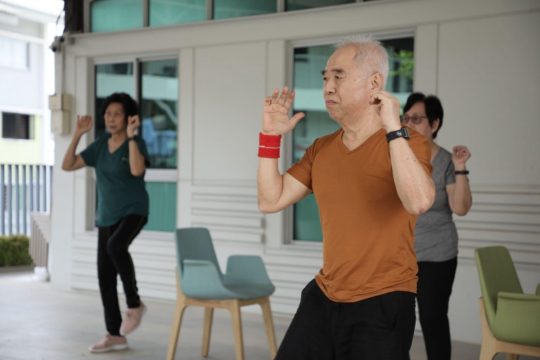
Ready to Take the Step Towards Better Mobility?
Sign up for NTUC Health’s Parkinson’s Exercise Class to be a part of an uplifting community and get the professional guidance you need to stay active and independent. Secure your spot now by filling up this form or visit our website to learn more!
Looking for more ways to manage Parkinson’s? Explore our care options here and find the right support for your needs.
1 Regular exercise is associated with slower progression of Parkinson’s motor and non-motor symptoms (Source 1) (Source 2)
2Research reveals strength training significantly improves functional capacity, power and quality in people with Parkinson’s.(Source)
3Up to 60% of individuals with Parkinson’s experience a fall each year. (Source)
4Structured balance training can reduce fall risk of people with Parkinson's by up to 40%. (Source)
